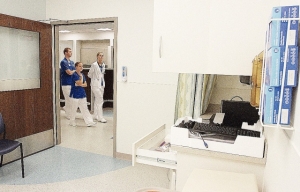Hospital's new emergency room opens Wednesday
By Phyllis Moore
Published in News on June 18, 2012 1:46 PM

News-Argus/ALLISON CARTER
Wayne Memorial Hospital workers Dennis Doering, Summer Blackman and Melissa Gooden walk past a recovery room in the hospital's new emergency wing. The new emergency department opens to the public Wednesday.
Long before work began on the new emergency room at Wayne Memorial Hospital, hospital officials visited other facilities to see what amenities would best meet the needs of the county's residents.
Denise Bruce, clinical director of the Wayne Memorial emergency department, said the aim was to give Wayne's residents the best the hospital could offer in the way of service and professionalism.
"We want to make it more comfortable for our patients and visitors," she said of the new facility, which will officially be unveiled and open to patrons Wednesday. "It's all about patient satisfaction and it's all about the patients knowing the nurses.
"We're trying to change the perceptions that a lot of people have about ERs," she added.
From colors chosen to layout and design, there are many subtleties about the new emergency room that won't be readily obvious to people, Mrs. Bruce said, but are nevertheless essential to running an efficient emergency care unit.
The $18 million construction project, begun in May 2011, more than tripled the size of the department, from 11,000 square feet to 35,000 square feet, and brought it from 22 patient beds to 42, plus four psychiatric beds.
Expansion was necessitated by the dramatic climb in demand for services. When the west wing of the hospital was built in 1991, the emergency room was designed for a capacity of 35,000 patient visits a year. In recent years, that number has been closer to 55,000 a year.
The layout of the new emergency department is all about ease -- for patients as well as physicians.
The entire area is divided into "pods," work stations set up identically and with "one way in, one way out" for patients to transition from check-in to discharge.
"ERs are chaotic," Mrs. Bruce said. "The goal in an ER is to keep the chaos under control."
Treatment rooms are designed to better accommodate movement of doctors and staff, as well as equipment and machines. Glass doors on each of the rooms also afford improved visibility from the nurses' stations.
"It's built so the nurses are not leaving the department (to do the job)," Mrs. Bruce said. "Our goal is to work smartly so we built it with everything for the patient in mind."
The treatment rooms are all about space to work, especially in the four trauma rooms where time may be at a premium. Doctors and staff need to be able to move about quickly, especially when additional machines need to be brought in.
As such, Mrs. Bruce said, they are kept pretty sparse. Most only contain a bed, rolling table for supplies, a couple chairs and a trash can, as well as a computer for the doctor to record information. A "boom" -- suspended from the ceiling, so it can be easily moved about without blocking the floor path -- provides for the immediate needs, such as oxygen lines, vacuum lines, air and electrical outlets.
A central hallway connects each pod, housing equipment and medications in close proximity. There is a physicians area, featuring double computer monitors so doctors can pull up information on a specific patient on one screen and utilize the second screen for other purposes, and a quiet room where attending physicians can conduct a consult or other business.
The emergency room also features an area to isolate patients, in cases of tuberculosis, respiratory and highly communicable disease cases, four psychiatric beds that are self-contained, and an "eye room" specifically for those with eye injuries.
Doctors are in the process of going completely paperless, Mrs. Bruce said, which means everything, including dictation and doctor's orders, will be documented onto computer.
All that remains is the actual move this week from what will be the former ED to the new one, located just to the left of the current department.
Wednesday morning, everyone there that day, with the exception of critical patients, will be relocated into the new facility. Half of the staff working at that point will make the move while the remaining staff will stay behind to clean up the equipment before it is also moved into the new department.
Mrs. Bruce said she hopes to have the transition completed in record time.
"Our goal was to have it done in three days. My goal is to have it done in eight hours," she said.
It might be a bit hectic right now, she admitted, as staff continues to sort through boxes and complete last-minute efforts before the official change-over. But it is undoubtedly a wise move.
"We need it," she said. "Our ER was only built (to handle) 35,000 patients a year. We're seeing 58,000, close to 60,000. That means longer wait times. That's never a good thing.
"So many things can happen that are negative in a waiting room. That's what you don't want to happen. We need this. The community needs this."
